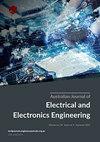基于直接转矩控制的异步电动机驱动不同策略转矩脉动的比较分析
Q3 Engineering
Australian Journal of Electrical and Electronics Engineering
Pub Date : 2022-01-26
DOI:10.1080/1448837X.2021.2023249
引用次数: 6
摘要
直接转矩控制(Direct Torque Control, DTC)方法是感应电机最突出、最熟练的控制技术之一。直接转矩感应电机驱动的最大缺点是转矩脉动大,逆变器开关频率可变。转矩脉动的主要原因是直接转矩控制中使用的转矩和磁链滞回带。直接转矩控制方法是利用滞回比较器产生高转矩脉动和不可预测的开关频率。本文讨论了基于模糊控制器(FLC)的三相异步电动机直接转矩控制(DTC)的转矩脉动分析。基于空间矢量脉宽调制(SVPWM)的直接转矩控制技术以规则的开关频率工作,有助于解决转矩脉动的基本问题。除此之外,文献提出了不同的解决方案,如预测方案、模糊逻辑控制器技术、全局最小转矩脉动策略、恒频转矩控制器(CFTC)技术、最优切换瞬间方案、占空比控制方案、SVPWM DTC等。直接转矩控制技术的模糊逻辑控制器功能被应用于感应电机(IM)驱动器的高性能应用。给出了异步电动机的传统直接转矩控制、SVPWM直接转矩控制、载波SVPWM直接转矩控制和FLC-DTC方法的仿真结果。对基于模糊的直接转矩控制技术与CSVPWM直接转矩控制方法和传统直接转矩控制方法进行了比较。采用基于flc的直接转矩控制方法,使5马力异步电动机的转矩脉动达到7.4%。对直接转矩感应电动机驱动的硬件结果也进行了演示和讨论。本文介绍了载波空间矢量脉宽调制(CSVPWM)和基于flc的直接转矩控制在减小转矩纹波方面的改进。本文章由计算机程序翻译,如有差异,请以英文原文为准。
Comparative Analysis of Torque Ripple for Direct Torque Control based Induction Motor Drive with different strategies
ABSTRACT Direct Torque Control (DTC) method is one of the most outstanding and proficient control techniques of the induction motor. The foremost drawback of DTC induction motor drive is high torque pulsation, variable frequency of inverter switching. The main reason of torque pulsation is torque and flux hysteresis band utilised in DTC. DTC method is utilising hysteresis comparators which produce high torque pulsation and unpredictable switching frequency. In this paper, torque ripple analysis of fuzzy logic controller (FLC) based Direct Torque Control (DTC) of three-phase induction motor drive has been discussed. The space vector pulse width modulation (SVPWM) based DTC technique, which operates with the regular switching frequency, helps to solve the fundamental issues of torque pulsation. In addition to this, literature proposes different solutions like a prediction scheme, fuzzy logic controller technique, global minimum torque ripple strategy, constant frequency torque controller (CFTC) Technique, optimal switching instant scheme, duty cycle control scheme, SVPWM DTC for torque ripple reduction. The fuzzy logic controller capabilities for DTC technique are applied with the induction motor (IM) drive for high-performance applications. The simulation results of Conventional DTC, SVPWM DTC, Carrier SVPWM DTC and FLC-DTC method for the induction motor are illustrated. Fuzzy-based DTC technique compared with CSVPWM DTC method and conventional DTC method are presented. The torque ripple of 7.4% for 5 HP induction motor is achieved by FLC-based DTC method. Hardware results for DTC induction motor drive are also demonstrated and discussed. This paper presents improvement in torque ripple reduction with the help of carrier space vector pulse width modulation (CSVPWM) and FLC-based DTC.
求助全文
通过发布文献求助,成功后即可免费获取论文全文。
去求助
来源期刊

Australian Journal of Electrical and Electronics Engineering
Engineering-Electrical and Electronic Engineering
CiteScore
2.30
自引率
0.00%
发文量
46
期刊介绍:
Engineers Australia journal and conference papers.
 求助内容:
求助内容: 应助结果提醒方式:
应助结果提醒方式:


